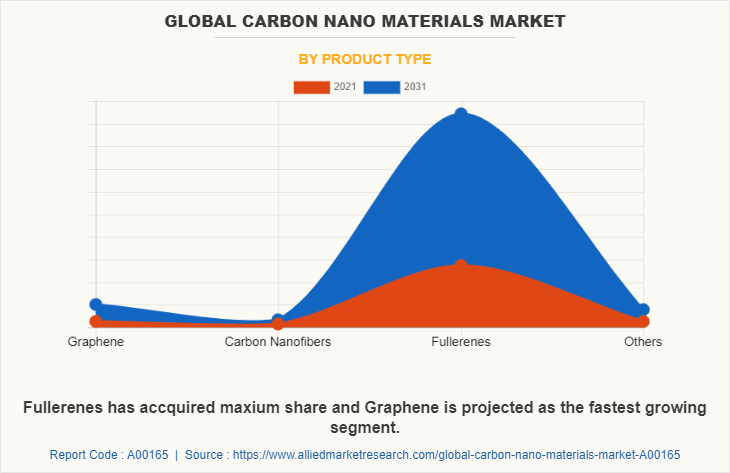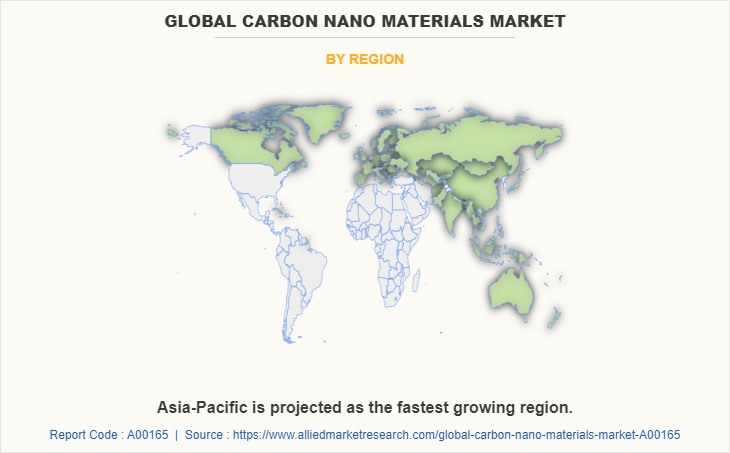Global Carbon Nano Materials Market Research, 2031
The global carbon nano materials market was valued at $2.9 billion in 2021, and is projected to reach $31.6 billion by 2031, growing at a CAGR of 27.7% from 2022 to 2031.The growth of the carbon nanomaterials market growth is driven by expansion in the automotive and aerospace industries, as well as rise in demand for carbon nano materials in electronics and semiconductors. Carbon nanomaterials enhance performance through their strength, conductivity, and lightweight properties, making them valuable for advanced applications in these sectors. Their integration into automotive, aerospace, and electronic components accelerates market expansion.
Carbon nanomaterials have excellent electrical, chemical, thermal, and mechanical properties. Carbon nanomaterials have uses in energy storage and conversion, composite materials, sensors, field emission devices, drug delivery, and nanoscale electronic components. Fullerenes, carbon nanotubes (CNTs), graphene and its derivatives, graphene oxide, nanodiamonds, and carbon-based quantum dots are examples of carbon nanomaterials (CQDs). Carbon nanomaterials have piqued the interest of a wide range of industrial applications due to their unique structural dimensions and improved mechanical, electrical, thermal, optical, and chemical capabilities.

Carbon nanomaterials have excellent electrical, chemical, thermal, and mechanical properties. Carbon nanomaterials have uses in energy storage and conversion, composite materials, sensors, field emission devices, drug delivery, and nanoscale electronic components. Fullerenes, carbon nanotubes (CNTs), graphene and its derivatives, graphene oxide, nanodiamonds, and carbon-based quantum dots are examples of carbon nanomaterials (CQDs). Carbon nanomaterials have piqued the interest of a wide range of industrial applications due to their unique structural dimensions and improved mechanical, electrical, thermal, optical, and chemical capabilities.
The rise in demand in automotive and aerospace industries is poised to be a pivotal driver for the carbon nanomaterials market.
The expansion of the automotive and aerospace industries significantly drives the growth of the carbon nanomaterials market. In the automotive sector, carbon nanomaterials are valued for their lightweight properties, high strength, and durability, which enhance fuel efficiency and overall vehicle performance. India's automotive industry is worth around $222 billion, while the EV market in India is estimated to be valued at $2 billion by 2023 and $7.09 billion by 2025. Further, the automotive industry accounts for 8% of all national exports. This sector accounts for 40% of the total $31 billion of global research and development spend. This surge in the automotive industry further drives the growth of the carbon nanomaterials market.
Similarly, the aerospace industry benefits from these materials due to their superior strength-to-weight ratio, which is crucial for reducing aircraft weight and improving fuel efficiency. According to the Aerospace Industries Association (AIA), the Aerospace and defense industry’s workforce generated $952 billion in combined sales in 2022, a 6.7 percent increase from the prior year. Additionally, the A&D industry generated $418 billion in economic value, which represented 1.65 percent of total nominal GDP in the U.S. As both industries continue to grow and innovate, the demand for advanced materials such as carbon nanomaterials rises. Their application in manufacturing high-performance components and systems helps meet industry demands for enhanced performance, safety, and sustainability, fueling market growth in these sectors.
Carbon nanoparticles are increasingly being used in the automobile industry for developing and producing car interiors and exteriors due to their excellent mechanical qualities and lightweight. In addition, they are widely used in automobiles to reduce aluminium engine weight, for improved grip and reduced rolling resistance, and in lithium-ion batteries to minimize charging time, increase tensile strength, and reduce vehicle weight. These factors are driving the global carbon nanomaterials market. However, growing concerns about the environmental impact of carbon nanoparticles have resulted in stricter regulations for carbon nanomaterials manufacturers. Carbon nanomaterial agglomerates pose a significant risk to humans and the environment. Carbon nanoparticles' harmful consequences on human health include an increased risk of high blood pressure, heart attacks, and kidney damage. They are fibrous in nature and, if inhaled, can cause health concerns. These health risks can hinder the market expansion of carbon nanomaterials. Carbon nanomaterials are also being used in aerospace applications such as coatings, cockpits, crew equipment, space durable mirrors, nozzles, equipment enclosures, aircraft interiors, and solar array substrates creates many opportunities for the carbon nanomaterials market.
The automobile industries in Japan and South Korea are expected to witness a rise in vehicle demand, leading to increased consumption of carbon nanomaterials. As both countries experience population growth and subsequent expansion in automobile production, the need for advanced materials to enhance vehicle performance and efficiency becomes crucial. Carbon nanomaterials offer benefits like lightweight strength and improved durability, which are highly valued in the automotive sector. This growing demand for vehicles in Japan and South Korea is projected to positively impact the carbon nanomaterial market, driving its expansion in these regions.
The global carbon nano materials market is segmented on the basis of form and region. Depending on form, the market is categorized graphene, carbon nano fibers, fullerenes and others). On the basis of region, the market is studied across North America, Europe, Asia-Pacific, and South America and Middle East Africa.

By Segment
The fullerenes segment accounted for the largest share i.e., 93.2% owing to its wide range of application in electronics products. Graphene segment is the fastest growing segment, growing around 31.0% CAGR over the forecasted period, this is due to increasing demand for graphene from automobile and energy industry.

By Region
Asia-Pacific acquired 37.9% market share in 2021 and is projected to grow at CAGR of 29.1% during the forecast period. Owing to the increased demand from automobile and electronics industries.
Japan and South Korea Overview
- Japan accquired 7.7% market share in Asia-Pacific region and is projected to grow at a CAGR of 25.7% during the forescated period.
- South Korea accquired 5.1% market share in Asia-Pacific region and is projected to grow at a CAGR of 27.8% during the forescated period.
- Rapid industrialization and increased investments in the medical and automotive industries in the emerging economies of South Korea, and Japan, these countries are anticipated to be the fastest-growing market.
- Companies have intensified R&D in carbon nanomaterials in response to increasing demand from several end-use sectors in the area of Japan and China, which is projected to have a favorable effect on the carbon nanomaterials market.
Major players operating in the global Carbon nanomaterials market include Arkema, Bayer AG, DuPont, G6 Materials Corp, Graphenea, Hollingsworth & Vose, Hydale Graphene Industries Plc, Hyperion Catalysis International, Inc., Jiangsu Cnano Technology Co.,Ltd, LG Chem, MTR Ltd., Nano-C, Nanocyl SA, Otto Chemie Pvt. Ltd., SES Research Inc, Showa Denko K.K, Thomas Swan & CO. Ltd, Tokyo Chemicals Industry UK Ltd. Other players operating in the Carbon nanomaterials market are Nanostructured & Amorphous Materials Inc., Nopo Nanotechnologies, Ocsial, Ossila Ltd., and Raymor Industries Inc.
Key Benefits For Stakeholders
- This report provides a quantitative analysis of the market segments, current trends, estimations, and dynamics of the global carbon nano materials market analysis from 2021 to 2031 to identify the prevailing global carbon nano materials market opportunities.
- The market research is offered along with information related to key drivers, restraints, and opportunities.
- Porter's five forces analysis highlights the potency of buyers and suppliers to enable stakeholders make profit-oriented business decisions and strengthen their supplier-buyer network.
- In-depth analysis of the global carbon nano materials market segmentation assists to determine the prevailing market opportunities.
- Major countries in each region are mapped according to their revenue contribution to the global market.
- Market player positioning facilitates benchmarking and provides a clear understanding of the present position of the market players.
- The report includes the analysis of the regional as well as global global carbon nano materials market trends, key players, market segments, application areas, and market growth strategies.
Analyst Review
According to the insights of the CXOs of leading companies, application of carbon nanomaterials as catalysts, superconductors, and others, in sectors such as automotive, military, electronics, and telecommunications is anticipated to be a major market driver. In recent years, electronics has become the major end-use industry for carbon nanomaterials, accounting for a substantial share of the market. The trend is anticipated to continue during the forecast period due to an increase in demand for electronics globally.
The automotive and defense industries are also anticipated to have a similar rise during the projection period, due to their rise in need for electronics. Undeveloped industries such as aerospace and energy offer tremendous opportunities for the carbon nanomaterial market. Graphene Nano platelet is the largest revenue-generating segment due to its superior product quality and volume production capability.
Energy storage is the largest revenue-generating segment for graphene and is expected to remain the same during the forecast period. In addition, in North America, rigorous R&D operations in the field of graphene are expected to deliver lucrative growth prospects for the graphene industry. The increase in investment across various corporate vertical lines, primarily to drive new R&D activities, is expected to increase regional market expansion. Graphene is primarily used in RFID, composites, sensors, R&D, energy storage, which is expected to drive their adoption; thus, driving carbon nano materials market growth.
Global Carbon Nano Materials Market Report Highlights
| Aspects | Details |
| By Product Type |
|
| By Region |
|
| Key Market Players | Jiangsu Cnano Technology Co., Ltd, MTR Ltd., G6 Materials Corp, Bayer AG, Arkema Group, LG Chem Ltd, hollingsworth & vose, Otto Chemie Pvt. Ltd, nanocyl sa, DuPont, Graphenea, Hydale Graphene Industries Plc, SES Research Inc, Nano-C, Hyperion Catalysis International, Inc. |
Analyst Review
According to the insights of the CXOs of leading companies, application of carbon nanomaterials as catalysts, superconductors, and others, in sectors such as automotive, military, electronics, and telecommunications is anticipated to be a major market driver. In recent years, electronics has become the major end-use industry for carbon nanomaterials, accounting for a substantial share of the market. The trend is anticipated to continue during the forecast period due to increase in demand for electronics globally.
The automotive and defense industries are also anticipated to have a similar rise during the projection period, due to their rise in need for electronics. Undeveloped industries such as aerospace and energy offer tremendous opportunity for the carbon nanomaterial market. Graphene Nano platelet is the largest revenue-generating segment in graphene-based products due its superior product quality and volume production capability.
Energy storage is the largest revenue-generating segment for graphene and is expected to remain the same in the forecast period. In addition, in North America, rigorous R&D operations in the field of graphene is expected to deliver lucrative growth prospects for the graphene industry. Increase in investment across various corporate vertical lines, primarily to drive new R&D activities, is expected to increase regional market expansion. Graphene is primarily used in RFID, composites, sensors, R&D, energy storage, which is expected to drive their adoption; thus, driving the market growth.
increasing usage of carbon nanomaterials in automobile and electrical industry.
The carbon nanomaterials market attained $2.9 billion in 2021, and is projected to reach $ 31.6 billion by 2031, growing at a CAGR of 27.7% from 2022 to 2031
Electrical and Electronics is the leading industry for Global Carbon Nano Materials Market
Asia-Pacific is the largest regional market for carbon nanomaterials market.
Arkema, Bayer AG, DuPont, G6 Materials Corp, Graphenea are some the top companies to hold the market share in Global Carbon Nano Materials.
Increased demand from automotive and electrical industry is driving the market growth.
COVID-19 had negative impact on carbon nanomaterials market growth owing to decreased demand from various end-use industry.
Loading Table Of Content...


